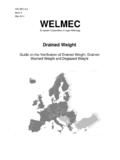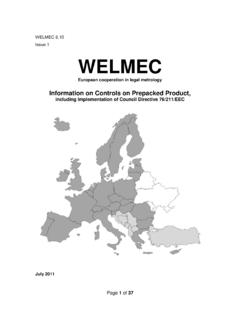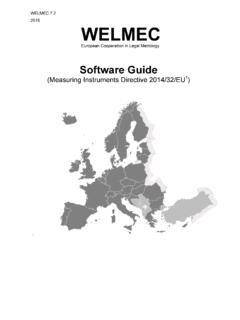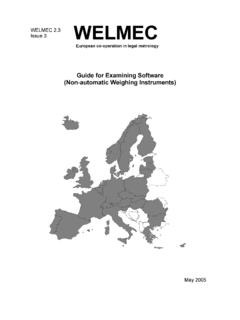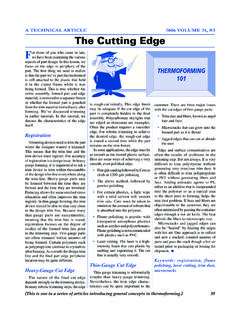Transcription of WELMEC Guide 8.11 2006
1 1 WELMEC Issue 1 WELMEC European cooperation in legal metrology Measuring Instruments Directive 2004/22/EC Water Meters Corresponding Tables OIML R 49 2006 and R 49-2 2004 MID-001 November 2006 2 WELMEC European cooperation in legal metrology WELMEC is a cooperation between the legal metrology services of the Member States of the European Union and EFTA. This document is one of a number of Guides published by WELMEC to provide guidance to manufacturers of measuring instruments and to notified bodies responsible for conformity assessment of their products. The Guides are purely advisory and do not themselves impose any restrictions or additional technical requirements beyond those contained in relevant EC Directives.
2 Alternative approaches may be acceptable, but the guidance provided in this document represents the considered view of WELMEC as to the best practice to be followed. Published by: WELMEC Secretariat Federal Office of Metrology and Surveying (BEV) Arltgasse 35 A-1160 Vienna Austria Tel: +43 676 8210 3608 Fax: +43 1 49 20 875 8006 Email : Website: WELMEC WG 11 Guide Issue 1 3 FOREWORD The Measuring Instruments Directive (MID) 2004/22/EC entered into force on the 30th October 2006 . In this new approach directive the presumption of conformity is mentioned in Article 13.
3 In addition to the use of harmonised standards (Art. 13 point 1) a new route is open for the presumption of conformity by using OIML recommendations (Art. 13 point 2). Member States shall presume conformity with the essential requirements referred to in Annex I and in the relevant instrument-specific Annexes in respect of a measuring instruments that complies with the corresponding parts of the normative documents and lists referred to in Article 16(1)(a), the references in respect of which have been published in the Official Journal of the European Union, C series. Article 4(i) defines that normative document means a document containing technical specifications adopted by the Organisation International de M trologie L gale (OIML), subject to the procedure stipulated in Article 16(1).
4 In Article 16 (1) (a) the functions of the Measuring Instruments Committee are described as follows: identify normative documents drawn up by OIML and, in a list, indicate the parts thereof compliance with which gives rise to a presumption of conformity with the corresponding essential requirements of this Directive . In the WELMEC Committee Meeting in May 2005 WELMEC agreed to support the work of the Commission on this issue and the MI-xxx Annexes of the MID has been given to the Working Groups of WELMEC to develop corresponding tables including comments as a basis for the publication foreseen in the Directive.
5 A timetable has been established and rules for drawing up these tables have been given by the WELMEC Committee. To prepare a proposal at least 3 experts has been involved. The drafts have been discussed in the responsible Working Group (including industry). The results have been sent do the WELMEC Secretariat and the WELMEC Committee Members has been asked for Comments. These drafts have been discussed during the WELMEC Committee Meeting in May 2006 and have been adopted as WELMEC guides. The documents have been sent to the European Commission for further consideration and for drafting the publication required in the directive.
6 This has been done in a small Working Group with the European Commission (June, July 2006 ). The European Commission presented the simplified tables to the Commission Working Group on Measuring Instruments for further comment and subsequently obtained a positive advice from the Measuring Instruments Committee on 25 September 2006 . The simplified tables are published In the Official Journal of the European Union, series C n 269, p I of 4 November 2006 . As guidance, WELMEC is publishing the full tables with all the comments and detailed information underlying the simplified tables to aid all interested and concerned parties.
7 The European Commission webpage gives the link to the documents of WELMEC . WELMEC WG 11 Guide Issue 1 Page 1 / 17 Final version adopted by WELMEC Committe reviewed after adoption of cross references by the Commission September 2006 Water meters Cross Reference Table 2004/22/EC vs. OIML R49 2006 and when mentioned R49-2 (2004) Directive 2004/22/EC Essential requirements of Annex 1 and Annex MI-001 OIML R49-1 ( 2006 ) (R49-2 (2004) when mentioned) Comment Water meters intended for the measurement of volumes of clean, cold or heated water in residential, commercial and light industry 1 water meters used to meter the actual volume of cold potable water and hot water Allowable errors Under rated operation conditions and in absence of a disturbance, the error of measurement shall not exceed the maximum permissible error (MPE)
8 Value as laid down in the appropriate instrument-specific requirements. Water meters shall be designed and manufactured such that their errors (of indication) do not exceed the maximum permissible errors as defined in or under rated operating conditions. The requirements relating to the maximum permissible errors shall be met for all temperature and pressure variations occurring within the rated operating conditions of the water meter. Unless stated otherwise in the instrument-specific annexes, MPE is expressed as a bilateral value of the deviation from the true measurement value. Accuracy class 2 water meters The maximum permissible error for the upper flowrate zone (Q2 Q Q4) is 2 %, for temperatures from 0,1 C to 30 C, and 3 % for temperatures greater than 30 C.
9 The maximum permissible error for the lower flowrate zone (Q1 Q < Q2) is 5 %. Under rated operating conditions and in presence of a disturbance, the performance requirement shall be as laid down in the appropriate instrument-specific requirements. Comment only. see responses to requirements of MI-001 Where the instrument is intended to be used in a specified permanent continuous electromagnetic field the permitted performance during the radiated electromagnetic field-amplitude modulated test shall be within MPE. Comment only. see responses to requirements of MI-001 WELMEC WG 11 Guide Issue 1 Page 2 / 17 Final version adopted by WELMEC Committe reviewed after adoption of cross references by the Commission September 2006 The manufacturer shall specify the climatic, mechanical and electromagnetic environments in which the instrument is intended to be used, power supply and other influence quantities likely to affect its accuracy.
10 Taking into account of the requirements laid down in the appropriate instrument-specific annexes. Water meters with electronic devices are divided into three classes according to climatic and mechanical environmental conditions (in accordance with OIML D11): - class B for fixed meters installed in a building - class C for fixed meters installed outdoors and - class I for mobile meters Water meters with electronic devices are divided into two electromagnetic environments: E1: Residential, commercial and light industrial; and E2: Industrial. The severity levels for each environmental requirement are defined in table Pattern approval certificate The following information shall appear on the pattern approval certificate: environmental classification, if applicable (see ) Climatic environments The manufacturer shall specify the upper temperature limit and the lower temperature limit from any of the values in Table 1 unless otherwise specified in the Annexes MI-001 to MI-010, and indicate whether the instrument is designed for condensing or non-condensing humidity as well as the intended location for the instrument, open or closed.


